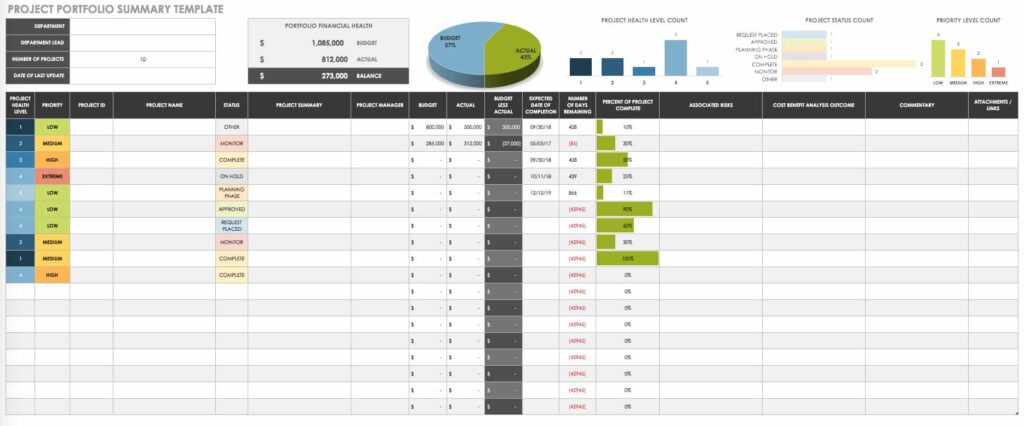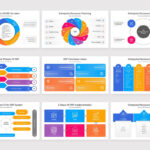In today’s dynamic business environment, effective project portfolio management (PPM) is not just a strategic advantage but a necessity. As organizations juggle multiple projects with limited resources, a structured approach becomes essential. This guide will walk you through using a Project Portfolio Management Template to streamline your project oversight. Whether you’re a seasoned project manager or just getting started, this guide will offer practical insights and actionable advice to elevate your portfolio management game.
For those looking to optimize project outcomes and resource allocation, this template serves as a powerful tool to centralize data, prioritize projects, and align them with organizational goals. With its structured format, it simplifies decision-making and provides actionable insights, making it an indispensable asset for any project manager.

What Is Project Portfolio Management?
Before diving into templates and tools, let’s clarify what Project Portfolio Management (PPM) entails. At its core, PPM is the centralized management of an organization’s projects to align with business objectives. It involves evaluating, prioritizing, and managing multiple projects to ensure optimal resource allocation and maximum ROI.
By using a project portfolio template, organizations can:
- Gain a holistic view of ongoing and proposed projects.
- Ensure alignment with strategic goals.
- Optimize resource utilization.
- Mitigate risks effectively.
Related Article: Project Portfolio Dashboard Template
Why Use a Project Portfolio Management Template?
Managing a portfolio of projects without a structured system is akin to navigating uncharted waters without a map. This template provides a clear framework, helping you:
- Standardize Processes: Templates ensure consistency in how projects are evaluated and reported.
- Enhance Visibility: Gain a bird’s-eye view of all projects in your portfolio.
- Improve Decision-Making: Leverage data-driven insights to prioritize projects.
- Save Time: Predefined templates reduce the time spent on manual documentation.
- Increase Collaboration: Facilitate smoother communication across teams.
Related Article: Change Management Communication Plan
Key Features:
Not all templates are created equal. Here are some essential features to look for:
1. Project Information Dashboard
This section should include basic details about each project, such as:
- Project name
- Start and end dates
- Project owner
- Status (e.g., on track, at risk, delayed)
2. Priority and Alignment Metrics
Evaluate how each project aligns with organizational goals. Include fields like:
- Strategic alignment score
- Business value
- Urgency level
3. Resource Allocation Tracker
Keep tabs on resource utilization:
- Assigned team members
- Budget vs. actual spend
- Resource availability
4. Risk and Issue Log
Anticipate and address challenges with a dedicated section for:
- Identified risks
- Mitigation plans
- Issue severity levels
5. Performance Metrics
Measure project success with key performance indicators (KPIs):
- Milestone progress
- Budget adherence
- Customer satisfaction ratings
Related Article: Work Order Template
How to Create Your Own Project Portfolio Management Template:
Creating a template tailored to your organization’s needs is simpler than you think. Follow these steps:
Step 1: Define Key Fields
Identify the critical information you need to capture. Refer to the “Key Features” section above as a starting point.
Step 2: Choose a Format
Excel remains a popular choice due to its flexibility and accessibility. However, project management software like Smartsheet or Monday.com can offer advanced functionalities.
Step 3: Customize for Your Organization
Ensure the template reflects your unique goals and workflows. For example:
- Add custom fields for industry-specific metrics.
- Integrate with existing tools, like CRMs or ERP systems.
Step 4: Test and Refine
Pilot the template with a small project portfolio before full-scale implementation. Gather feedback from team members and refine as needed.
Related Article: scope management plan template
Common Challenges in Project Portfolio Management (And How Templates Help):
1. Lack of Clarity
Without a clear overview, teams often struggle to prioritize. A template provides structure and clarity, ensuring everyone is on the same page.
2. Resource Conflicts
Overcommitted resources can derail projects. Templates help track availability and allocate resources effectively.
3. Poor Risk Management
Unanticipated risks can jeopardize project outcomes. A risk log within your template ensures proactive identification and mitigation.
4. Inefficient Communication
Miscommunication leads to delays and misunderstandings. Templates act as a centralized repository for all project-related data, improving collaboration.
Related Article: Agile Project Planning Template
Tips for Optimizing:
- Keep It Simple: Avoid overcomplicating the template. Focus on capturing essential data.
- Update Regularly: Ensure the template reflects the latest project status and metrics.
- Train Your Team: Provide training to ensure everyone understands how to use the template effectively.
- Leverage Integrations: Connect your template with other tools (e.g., Jira, Trello) for seamless data flow.
- Review Periodically: Revisit and refine the template to align with evolving business needs.
Related Article: Portfolio management
Conclusion:
Effective project portfolio management is no longer optional; it’s a strategic imperative. By leveraging a well-designed Project Portfolio Management Template, you can streamline processes, enhance decision-making, and drive organizational success. Whether you choose a basic Excel sheet or a sophisticated software solution, the key lies in tailoring the tool to your unique requirements.
My Personal Experience:
Personally, I’ve used this template in my own projects, and it’s been a game-changer. The clarity it provides, combined with its ease of use, has significantly improved my ability to manage multiple projects efficiently. It’s one tool I can’t recommend enough.
Ready to transform your project management approach? Start building your customized project portfolio template today and witness the impact firsthand. Remember, success isn’t just about managing projects—it’s about managing them with purpose and precision.
FAQ’s:
1. How to make a project portfolio template?
To create a project portfolio template, begin by defining project categories and prioritizing them based on their strategic importance. Use tools like Excel for a simple, customizable template or opt for specialized software for a more comprehensive solution. Incorporate columns for project details such as timelines, budgets, and resources.
2. What is PPM and PMO?
PPM (Project Portfolio Management) refers to the process of managing a collection of projects, ensuring they align with organizational strategy. PMO (Project Management Office) is the department or team responsible for overseeing project management standards, processes, and ensuring projects are completed successfully.
3. How do you structure a project portfolio?
A project portfolio is typically structured based on factors like project type, priority, resource allocation, and strategic alignment. You can use a Project Portfolio Management Template to organize this information clearly. Tools like Excel are useful for visualizing and managing portfolio elements like budgets, deadlines, and performance metrics.




